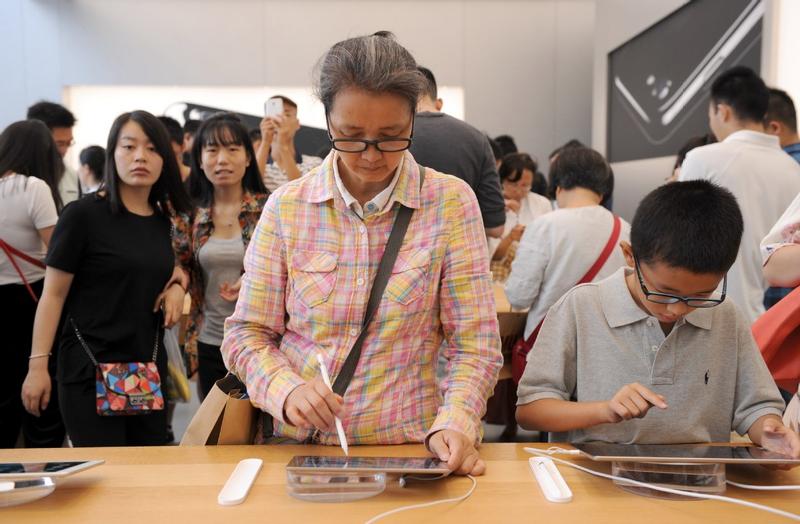 In this Feb 20, 2020 file photo, a worker manufactures glass products to be used on tablets and smartphones at an optoelectronics technology company in Chongqing's Dazu High-tech Zone. (LUO GUOJIA / CHINA DAILY)
In this Feb 20, 2020 file photo, a worker manufactures glass products to be used on tablets and smartphones at an optoelectronics technology company in Chongqing's Dazu High-tech Zone. (LUO GUOJIA / CHINA DAILY)
China has long been known as a global information technology manufacturing powerhouse, but an interesting shift has been going on within the nation for years, that many have failed to notice.
One out of every three laptop computers sold worldwide, and one out of every 10 smartphones sold globally now come from Chongqing, the southwestern Chinese municipality. And 70 percent of the world's iPads and nearly 20 percent of global laptop computers are now produced in Chengdu, capital of Southwest China's Sichuan province
As industrial transfer gains momentum within the country, western China, which used to be known as being underdeveloped, has already emerged as an important new production base for global consumer electronic products.
One out of every three laptop computers sold worldwide, and one out of every 10 smartphones sold globally now come from Chongqing, the southwestern Chinese municipality. At the same time, 70 percent of the world's iPads and nearly 20 percent of global laptop computers are now produced in Chengdu, capital of Southwest China's Sichuan province.
The size of the electronic information sector in Chengdu and Chongqing now accounts for about one third of that of the global electronic information industry, according to a report from Chengdu Daily, which is affiliated with the local government.
ALSO READ: Chengdu auto show a sign of enthusiasm, resolution
Statistics show that contrary to some perceptions that many manufacturing plants have been relocated out of China due to rising labor costs, the reality is that many industries are just moving from East China to western China. The latter now has advantages in both industrial infrastructure and production costs, company executives and experts said.
 In this updated file photo, consumers try out iPads at a flagship Apple store in Chengdu, capital of Sichuan province.( WANG ZHENGWEI / CHINA DAILY)
In this updated file photo, consumers try out iPads at a flagship Apple store in Chengdu, capital of Sichuan province.( WANG ZHENGWEI / CHINA DAILY)
On Aug 21, Premier Li Keqiang called upon western regions to give further play to their strengths and proactively undertake the transfer of industries from the east so as to move further up industry chains.
Li made the remarks during an inspection trip to Chongqing. Dai Bin, director of the Research Center for Regional Economics and Urban Management at Southwest Jiaotong University, said western China has a relatively good industrial foundation and also boasts universities focusing on electronics research.
These factors have helped the region efficiently attract consumer electronics plants which have been moved out of East China.
"Also, the electronic information industry features a global market that mainly relies on air transport. As a result, building factories in western China does not have a location disadvantage compared with that of the east," Dai said.
In the first half of 2020, the electronic information industry in Chengdu grew 11.3 percent year-on-year, despite the fallout from the COVID-19 outbreak, according to official data. When it comes to Sichuan province as a whole, the combined manufacturing of computers, telecommunications equipment and other electronic products jumped 13.2 percent year-on-year in the first seven months.
The Chongqing Commission of Economy and Informatization, the local industry regulator, told Chongqing Daily: "The smart terminal industry, represented by laptops and smartphones, has become the main driving force for the city's industrial growth."
In the first half, Chongqing's smart terminal industry achieved a combined import and export output value of 138.64 billion yuan (US$20.6 billion), marking an increase of 3.7 percent year-on-year and accounting for more than half of Chongqing's total foreign trade value during the period.
ALSO READ: Ant Group to set up unit in Chongqing
The city exported 25.5 million laptops in the first six months, marking a jump of 7.9 percent year-on-year.
Its export value of laptops hit 72.48 billion yuan, also an increase of 4.9 percent year-on-year. Chongqing was ranked first in China in these indicators, according to official data.
Major Chinese smartphone vendors such as Oppo and Vivo have also opened factories in Chongqing. In September, the second phase of Vivo's Chongqing research, development and production base has started construction.
Vivo said it plans to invest 460 million yuan to build the base, which will cover 100,000 square meters and be completed in 2024.Vivo built the first phase of its Chongqing plant in 2014, and the facility produced 10.49 million smartphones in the first half.
The company's southwestern headquarters will work hard to serve the industrial internet and digital economy construction, and help form an important growth pole for high-quality development in western China.
Pony Ma, chairman and CEO of Tencent
Yi Xiaoguang, dean of the Chongqing Comprehensive Economic Research Institute, said Chongqing has made good use of industrial transfer opportunities after the 2008 financial crisis to attract a string of electronics manufacturing companies.
Now, an industry cluster has already come into being in Chongqing, which has helped the city process more orders even amid the COVID-19 outbreak.
"At the same time, Chongqing is stepping up its push to promote the integration of the digital economy and the real economy, which helps accelerate the transformation of traditional sectors and nurture a bigger market for the application of electronic products," Yi said.
Pony Ma, chairman and CEO of Chinese tech giant Tencent, said the company will further increase investment in new infrastructure through its southwestern headquarters located in Chongqing.
"The company's southwestern headquarters will work hard to serve the industrial internet and digital economy construction, and help form an important growth pole for high-quality development in western China," Ma said in a speech at the third Smart China Expo, which was held in Chongqing in September.
In addition to the Sichuan-Chongqing region, the electronic information manufacturing sector has become the main growth driver for other regions in western China. After South Korean tech giant Samsung opened its factory in Xi'an, capital of Northwest China's Shaanxi province, Xi'an became a new force on the map in the electronic information industry.
From January to July of this year, the number of computer, communications and other electronic equipment manufacturers in Xi'an grew by 46.7 percent year on year
From January to July of this year, the number of computer, communications and other electronic equipment manufacturers in Xi'an grew by 46.7 percent year on year. The first phase of Samsung's chip plant in Xi'an achieved its full capacity of 130,000 memory chips per month in both January and February, according to Samsung China Semiconductor Co Ltd.
The company said they are pushing forward construction of the second phase as planned. Hyunki Ji, vice-president of Samsung China Semiconductor Co Ltd, said earlier that the local government has provided support to ensure the smooth operation of the company's plant in Xi'an, which did not suspend operations during the Spring Festival holiday, with a series of anti-epidemic measures in place to ensure safe work and production.
Manish Bhatia, executive vice-president of global operations at United States chip giant Micron, also said in an earlier interview with China Daily that its manufacturing plant in Xi'an saw record production despite the COVID-19 pandemic, further reiterating the company's commitment to China.
The chipmaker took a series of measures to ensure the health and safety of its employees in the country at a very early stage of the outbreak.
"China is a very important market for us," Bhatia said, adding that the company is not changing its plans for the nation. Its Xi'an facility will continue running at full throttle, and Micron will continue introducing new products.
READ MORE: B&R behind robust trade growth of China's inland provinces
Yi from the Chongqing Comprehensive Economic Research Institute said western China has made strides in attracting consumer electronics manufacturing companies in recent years. The next step will be to attract more high-end manufacturers to settle down and help accelerate the formation of industrial chains, technology chains and supply chains among Chengdu, Chongqing, Xi'an and surrounding cities.


